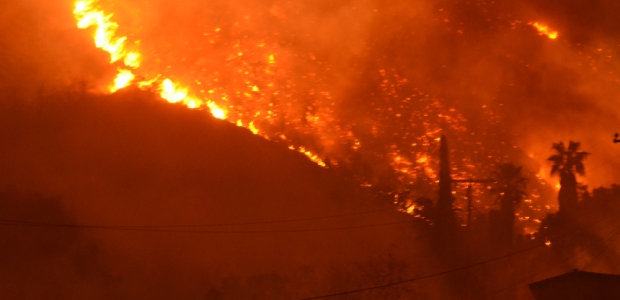
PG&E, Other California Utilities File 2019 Wildfire Mitigation Plans
More than half of PG&E's 70,000-square-mile service area is in extreme or elevated fire-threat areas. The plan includes the expansion of PG&E's Public Safety Power Shutoff program to include all electric lines that pass through high fire-threat areas, both transmission and distribution.
Pacific Gas and Electric Company has submitted its 2019 Wildfire Safety Plan to the California Public Utilities Commission (CPUC), pledging to expand and add to the safety precautions PG&E began implementing in 2017 and 2018 to address the growing threat of extreme weather and wildfires across its 70,000-square-mile service area. The plan includes expanding and enhancing PG&E's Community Wildfire Safety Program, expanding PG&E's vegetation management around power lines, conducting enhanced safety inspections of electric infrastructure in high fire-threat areas, and hardening its electric system.
It also includes the expansion of PG&E's Public Safety Power Shutoff program to include all electric lines that pass through high fire-threat areas, both transmission and distribution. "While customers in high fire-threat areas are more likely to be affected, any of PG&E's more than 5 million electric customers could have their power shut off for safety only as a last resort when forecasted fire danger conditions warrant," according to the company's Feb. 6 news release.
"We know how much our customers rely on electric service. Proactively turning off power is a highly complex issue with significant public safety risks on both sides, all of which need to be carefully considered and addressed," said Michael Lewis, Electric Operations senior vice president. "We understand and appreciate that turning off the power affects first responders and the operation of critical facilities, communications systems, and much more. We will only turn off power for public safety and only as a last resort to keep our customers and communities safe."
The expanded PSPS includes timely notification to customers of potential shutoffs. The program will now include 25,200 distribution circuit miles, up from 7,100 last year, and about 5,500 circuit miles of transmission lines including 500 kV, up from 373 circuit miles of transmission lines at 70 kV and below, across elevated and extreme-fire risk areas, designated by the CPUC High Fire Threat District map adopted in January 2018.
More than half of PG&E's service area is in extreme or elevated fire-threat areas, the release says.
"Our state is faced with an extended and more dangerous wildfire season that demands urgent action and coordination. While California's energy companies have a critical responsibility and role to play in reducing wildfire risk, we must all work together to keep our communities safe," said Sumeet Singh, vice president of the Community Wildfire Safety Program. "The wildfire safety actions and programs described in our 2019 plan address the company's unique and diverse service area and provide our regulators, customers, and communities with transparency of our unwavering efforts to help further reduce the risk of wildfire and improve public safety."
The plans indicates the company's new safety steps and actions include these:
- Installing nearly 600 new high-definition cameras, made available to CAL FIRE and local fire officials, in high fire-threat areas by 2022, increasing coverage across high fire-risk areas to more than 90 percent
- Adding approximately 1,300 additional new weather stations by 2022, at a density of one station roughly every 20 circuit miles in high fire-risk areas
- Conducting enhanced safety inspections of electric infrastructure in high-fire threat areas, including approximately 725,000 electric towers and poles across more than 5,500 transmission line miles and 25,200 distribution line miles
- Further enhancing vegetation management efforts across high-fire risk areas (25,000 miles of lines) to address vegetation that poses a higher potential for wildfire risk, including clearing overhanging branches directly above and around power lines
- Continuing to disable automatic reclosing in high fire-threat areas during wildfire season and periods of high fire-risk and upgrading more reclosers and circuit breakers in high fire-threat areas with remote control capabilities
- Installing stronger, more resilient poles and covered power lines, including targeted undergrounding, starting in areas with the highest fire risk and ultimately upgrading and strengthening approximately 7,100 miles during the next 10 years
- Partnering with additional communities in high fire-threat areas to create new resilience zones that can power central community resources during a Public Safety Power Shutoff
The safety plan builds on PG&E's Community Wildfire Safety Program, which was launched in March 2018. PG&E says in the plan that it benchmarked with several utilities, including San Diego Gas & Electric Company and several Australian utilities, in designing its approach.
Senate Bill 901 in California requires electric utilities to prepare and submit wildfire mitigation plans that describe their plans to prevent, combat, and respond to wildfires affecting their service territories. The CPUC will review the plans, modify the plans when necessary, and eventually adopt plans. The bill also directs the CPUC to pursue enforcement actions for non-compliance with the plans. Utilities that are required to file are Pacific Gas and Electric Company, Southern California Edison, San Diego Gas & Electric, Liberty Utilities/CalPeco Electric, Bear Valley Electric Service, and Pacific Power.
The agency has scheduled workshops and hearings in February and March and is accepting public comments.